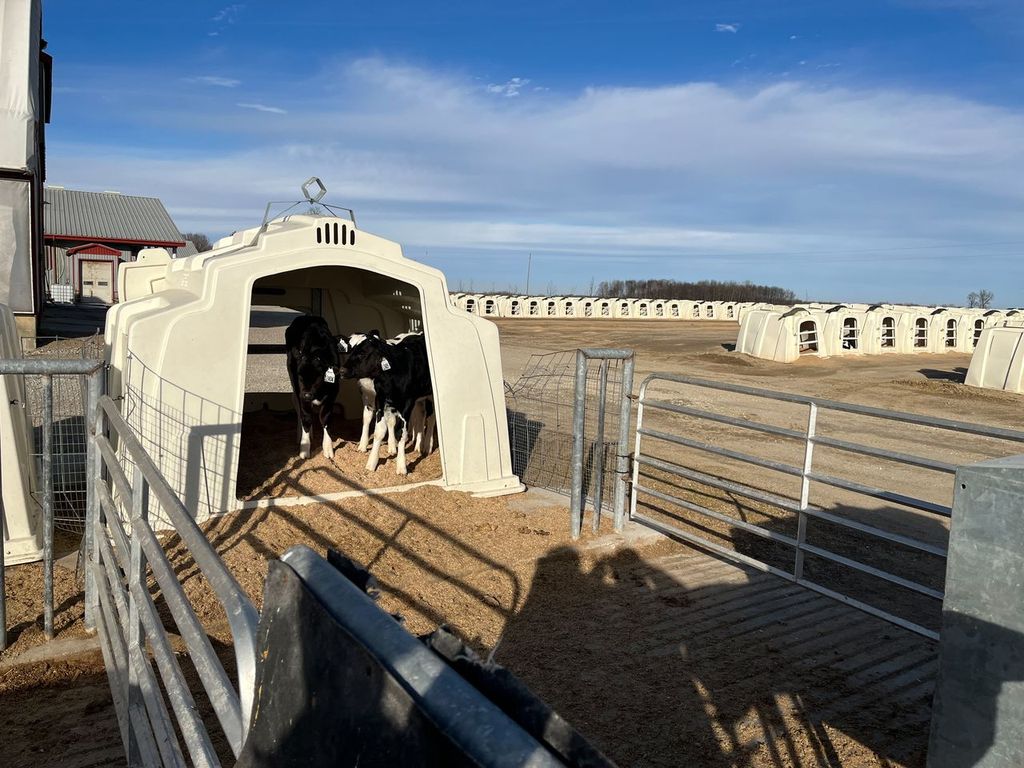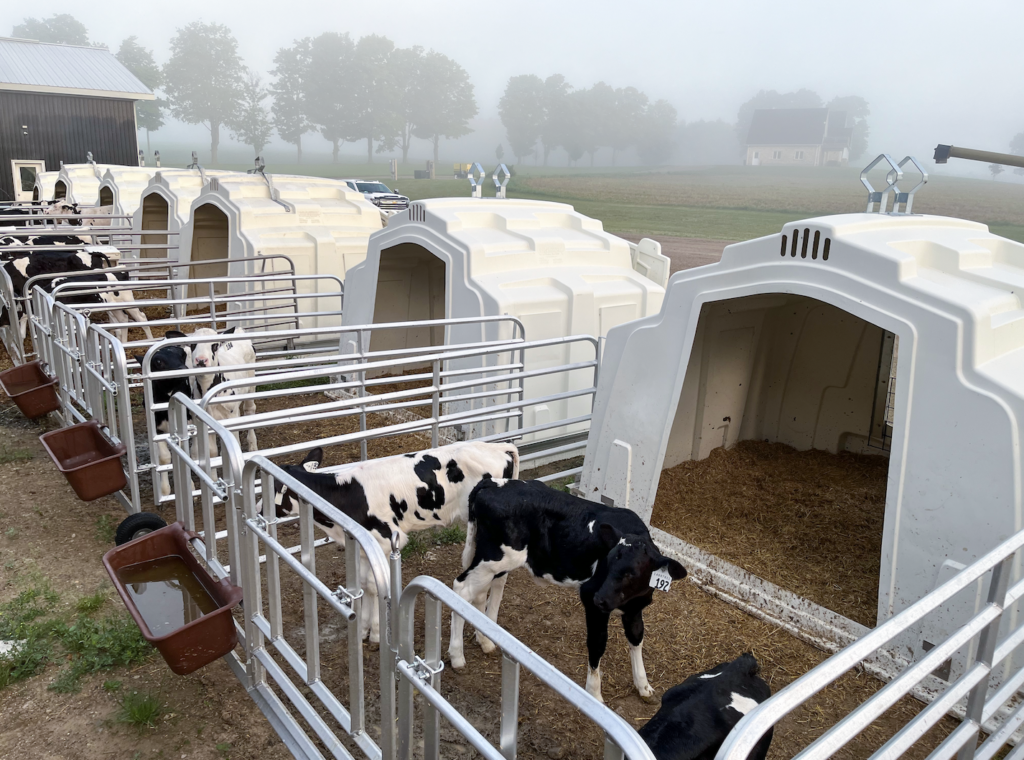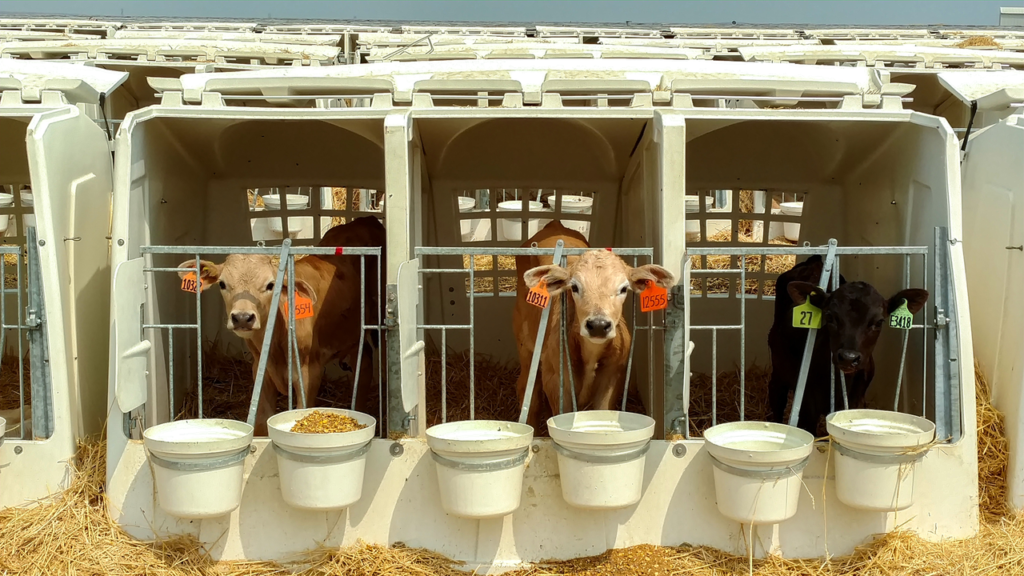Intro – Outdoor Calf Housing
To choose the best outdoor calf housing for your calves, prioritize options that offer excellent ventilation, durability, and ease of cleaning.
Your farm will benefit from a well-designed and implemented outdoor housing for calves. Your operations will run more smoothly, and your calves will have an environment in which to grow happy and healthy. Many studies have found certain advantages to the different approaches to calf housing, including single, paired, and group housing options.
Single-calf housing options help limit the spread of diseases, while group housing facilitates their natural herd instincts and social development. Many considerations go into this decision for your operation.
The experts at Agri-Plastics have taken traditional calf housing and refined and improved the designs to promote calf health while improving the efficiency of the operation. Check out our calf hutch options today!
Key Takeaways
- Health Impact: Proper housing improves calf health.
- Ventilation Matters: Outdoor housing offers better air circulation.
- Variety of Options: Choose from single, paired, or group hutches.
- Long-term Benefits: Good housing leads to healthier, more productive calves.
- Consider Specific Needs: Match housing features to your farm’s unique requirements.
Individual vs. Pair vs. Group Calf Housing: Key Considerations
| Type of Housing | Health Benefits | Behavioral Impact | Management Complexity | Space Requirements |
| Single Hutches | Minimizes disease spread; easy to isolate sick calves. | Limited social interaction; potential stress during later group integration. | Simplified feeding and monitoring; less competition. | Requires more land space per calf but ensures individual attention. |
| Paired Hutches | Supports immune system development through limited social contact. | Encourages social skills; reduces weaning stress. | Moderate management needed to ensure equal feeding. | Efficient use of space; slightly less land required than single hutches. |
| Group Housing | Promotes natural immunity through exposure; requires strict health management. | Fosters social behavior; smoother transition to group environments. | High management needed to prevent bullying and competition. | Requires the least amount of space per calf but demands careful planning and supervision. |
Understanding the Basics of Outdoor Calf Housing
Outdoor calf housing is an effective solution for raising healthy calves while reducing the risk of disease.
These structures provide significantly better ventilation than indoor systems. Ventilation is a top priority in livestock housing systems. Consistent fresh air is vital for maintaining respiratory health.
The design of outdoor housing also aids in minimizing the spread of diseases. An effective system ensures calves remain robust and thrive in their early stages of development.

Key Features to Look for in an Outdoor Calf Hutch
When selecting an outdoor calf hutch, a few key features can make all the difference in your calves’ health and the efficiency of your farm operations.
Ventilation is at the top of the list, as it directly affects the air quality inside the hutch.
Durability is another critical factor. The hutch needs to withstand harsh weather conditions while remaining intact for years.
Ease of cleaning plays a vital role in maintaining a sanitary environment and keeping disease at bay.
Top 5 Key Features to Consider
- Ventilation: Keeps fresh air flowing, essential for calf respiratory health.
- Durability: Withstands harsh weather, ensuring long-term use without frequent replacements.
- Ease of Cleaning: Simplifies maintenance, promoting a healthier environment for calves.
- Size and Space: Provides adequate room for growth and movement, preventing overcrowding.
- Accessibility: Easy for farmers to access for feeding, cleaning, and monitoring calf health.
Types of Outdoor Calf Hutches
Single Calf Hutches
Single calf hutches are designed for individual care. They allow you to monitor each calf closely.
These hutches offer the best disease control as calves are isolated – reducing the risk of cross-infection. However, they require more space.
Models like the Deluxe and Rancher Hutches from Calf Hutch are popular choices due to their robust design and superior ventilation features.
Paired Calf Hutches
Paired calf housing offers a middle ground by allowing two calves to share a space.
This setup encourages social interaction with the added benefit of shared warmth for those in colder climates.
The Supreme Buddy Hutch is an excellent example. These provide enough space for two calves while maintaining easy access for feeding and care. Paired and group options always come with the consideration of disease spread, so be sure to monitor the health of your calves closely.
Group Calf Hutches
Group calf hutches are ideal for transitioning calves from individual to group housing.
These hutches support social behavior development and reduce the stress of isolation. Group Hutches by Calf Hutch are built to accommodate several calves to promote interaction while still providing enough space to prevent overcrowding.
Proper management is essential to avoid issues like bullying and ensure all calves receive adequate nutrition. (1)

Comparing Outdoor Calf Hutch Materials
The material of a calf hutch significantly impacts its durability, insulation, and ease of maintenance.
Plastic and wood are the most common materials used.
Plastic hutches are lightweight, easy to clean, and resistant to rot, making them a low-maintenance option.
Wood, on the other hand, offers better insulation, which is beneficial in extreme weather conditions, but it requires more upkeep to prevent rotting and pest infestations.
Outdoor Calf Housing Material Comparison Table
| Material | Durability | Insulation | Maintenance | Cost |
| Plastic | High, resistant to rot | Moderate | Low, easy to clean | Affordable |
| Wood | Moderate, prone to rot | High | High, requires regular treatment | Higher |
Common Mistakes to Avoid When Choosing an Outdoor Calf Hutch
One common mistake farmers make is overlooking the importance of proper ventilation. Poor ventilation can lead to respiratory issues, stunted growth, and a generally unhealthy environment for calves.
Another pitfall is choosing a hutch that is too small. Calves need adequate space to move around and grow, and a hutch that’s too cramped can lead to stress and physical discomfort.
To avoid these mistakes, always prioritize ventilation and space when selecting a hutch.
Ensure that the hutch provides enough room for each calf to stand, lie down, and move freely. Regular maintenance and sanitation practices are also crucial in preventing disease and promoting overall calf health.
Investing in a high-quality hutch may cost more upfront – but it will save you time and money in the long run by keeping your calves healthier and reducing the need for frequent replacements.
Wrapping Up: Outdoor Calf Housing with Calf Hutch
Livestock operations are an indispensable part of agriculture and food supply chains. As a society, it is in everyone’s best interest to keep the innovations towards improved farming operations moving forward.
That is Calf Hutch’s mission: to improve the efficiency and health of livestock operations.
These hutches are made by farmers for farmers. They feature the small details that improve all aspects of your operation that other manufacturers miss. Explore our range of high-quality products to find the perfect fit for your calves!
Visit CalfHutch.com for more information and resources!
Reference:
- Penn State, Individual Vs. Paired Calf Housing, https://extension.psu.edu/individual-vs-pair-calf-housing

